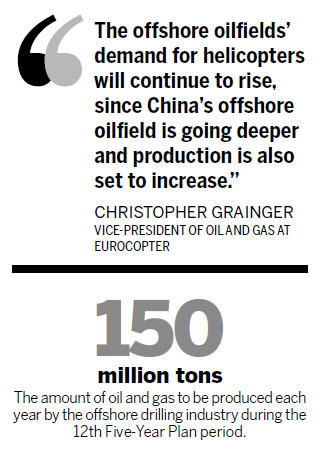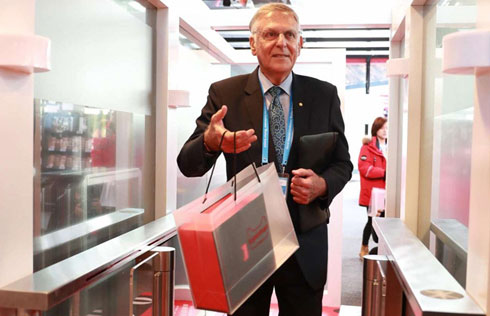Boomtime for China's offshore chopper fleet

China's booming offshore oil industry is fueling a growing demand for helicopters, and some operators are now planning to double the size of their fleets over the next couple of years.
The largest supplier of new aircraft in the region predicts that the number of helicopters in the skies above the oil-rich Chinese waters will increase from the current 300 to more than 1,000 in the next decade.
The country's helicopter services industry is now dominated by three main players: CITIC Offshore Helicopter Co Ltd, China Southern Airlines Co Ltd's Zhuhai helicopter branch and Eastern General Aviation Corp Co Ltd .
Officials at the Shenzhen-based COHC, with a 56 percent share of the market, say it will deliver the basic service of transporting workers to and from rigs and dealing with emergencies and plans to expand its scope into helicopter training, maintenance and onshore services.
The Zhuhai helicopter branch of China Southern, with a 30 per cent share of the offshore sector, plans to expand its fleet from 17 to 50 helicopters by 2020.
Liu Jianxin, deputy general manager of COHC, says it is about to take a delivery of 11 new helicopters from Eurocopter SAS, the leading European helicopter manufacture, over the next three years, adding to the 41 it operated at the end of last year, which included 23 working exclusively offshore.
"COHC has seen its fastest development ever over the past two years, since we started operations in 1983," says Liu, a direct result of the booming Chinese offshore oil sector.
According to China National Offshore Oil Corp, the sector will achieve an annual production rate of 150 million tons of oil and gas during the 12th Five-Year Plan period, and production from deep sea exploration will be 50 million tons of that, suggesting the good times are set to continue for those main helicopter operators.
The demands on the helicopter crews off the coasts of China are considerable, and often dangerous.
COHC used all its helicopters in Shenzhen to move more than 200 staff members from rigs in the South China Sea on June 19, when a typhoon threatened the area.
According to Christopher Grainger, vice-president of oil and gas at Eurocopter, China's offshore oil and gas industry is his main customer, and a quarter of the 120 Eurocopter craft in the country operate to and from fields.
"The offshore oilfields' demands for helicopters will continue to rise, since China's offshore oilfield is going deeper and production is also set to increase," he said.
The European manufacturer held a seminar in Shenzhen from Monday to Wednesday to work out how best to meet the growing demand.
Jian Zhuodong, deputy general manager of Zhuhai Helicopter Branch of China Southern Airlines Co Ltd, says his firm will be expanding its fleet by more than 50 percent to 50 choppers by 2020.
"We are working on recruiting pilots and crews for the future expansion," he adds.
He's justifiably optimistic about the business for offshore oilfields and says larger helicopters will be needed as oilfields dig into deeper waters.
The business for offshore oil is very much the operators' main profit source, contributing about 80 percent to COHC's total income in the past two years, adds Liu, taking it to 987 million yuan ($155.15 million) in 2011, a 12.2 percent increase from 2010.
"The business for offshore oilfields supplies the cash flow to our company," says Jian Zhuodong, of China Southern Airlines.
Oil exploration firms generally pay the helicopter operators a daily rental fee for their services, and extras can be charged depending on flight times. But as in any growing market situation, the more business there is, the more competition arrives.
"We do worry about a price war in the field, and the competition is getting harder," says Jian, explaining that offshore business is almost many operators' only profitable arm, despite still undercutting international prices by around 10 percent.
In COHC's recent annual report, the firm called maintaining its leading position in the offshore marketplace "more challenging than ever", meaning all the Chinese helicopter operators are being forced to invest in their fleets.
"We have heavy pressure now," adds Liu, the deputy general manager. Its fleet and service upgrading will continue apace, he says.
The leading operator bought seven EC225 helicopters from Eurocopter in December 2011, the manufacture's largest type, having 19 seats. COHC plans to supply multiple services using its various helicopters, including training, maintenance and onshore service.
Eurocopter got orders worth 300 million euros ($381 million) in China in 2011, more than double its 2010 sales.
Future activities such as oil prospecting, oil pipe patrols and other work also present massive further potential business for operators, as well as offshore wind power projects.
"I believe wind farm could be an important customer for helicopter operators in the future," adds Bernd Brucherseifer, managing director of HTM Helicopter Travel Munich GmbH in Germany, one of the world's oldest helicopter operators working on offshore wind farms.
Christopher Grainger from Eurocopter says his order book is open and ready for the Chinese offshore helicopter industry to continue to boom.
"Business will be larger in the future," he says.
wangwen@chinadaily.com.cn
(China Daily 06/21/2012 page14)














